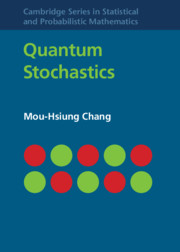Book contents
- Frontmatter
- Dedication
- Contents
- Preface
- Introduction and Summary
- 1 Operator Algebras and Topologies
- 2 Quantum Probability
- 3 Quantum Stochastic Calculus
- 4 Quantum Stochastic Differential Equations
- 5 Quantum Markov Semigroups
- 6 Minimal QDS
- 7 Quantum Markov Processes
- 8 Strong Quantum Markov Processes
- 9 Invariant Normal States
- 10 Recurrence and Transience
- 11 Ergodic Theory
- Bibliography
- Index
5 - Quantum Markov Semigroups
Published online by Cambridge University Press: 05 February 2015
- Frontmatter
- Dedication
- Contents
- Preface
- Introduction and Summary
- 1 Operator Algebras and Topologies
- 2 Quantum Probability
- 3 Quantum Stochastic Calculus
- 4 Quantum Stochastic Differential Equations
- 5 Quantum Markov Semigroups
- 6 Minimal QDS
- 7 Quantum Markov Processes
- 8 Strong Quantum Markov Processes
- 9 Invariant Normal States
- 10 Recurrence and Transience
- 11 Ergodic Theory
- Bibliography
- Index
Summary
In this chapter, we define and explore basic properties of a quantum Markov semigroup {It, t ≥ 0} of linear maps on the C* -algebra or von Neumann algebra A that characterizes the quantum system. The quantum Markov semigroup (QMS) plays a key role in describing quantum Markov processes that are to be explored in the subsequent chapters. The concept of QMS extends the semigroup of probability transition operators {Tt, t ≥ 0} for a classical Markov process to its noncommutative counterpart. Suppose the classical Markov process {Xt, t ≥ 0} is defined on the complete filtered classical probability space (Ω, Ƒ, P; {Ƒt, t ≥ 0}) and with values in a measurable space (핏, B (X)). Recall that for each t ≥ 0, the probability transition operator Tt: L∞ (X, B (X)) → L∞ (X, B (X)) by
(Ttf)(Xs) = Ex[f(Xs+t) | Ƒs] ∀s, t ≥ 0.
A semigroup of linear maps on the C* -algebra or von Neumann algebra A is said to be a quantum dynamical semigroup (QDS) if (i) I0 = J (the identity operator on A); (ii) ItIs = It+s for all t, s ≥ 0; (iii) It is completely positive for each t ≥ 0; and (iv) It is σ weakly continuous on A, i.e., a ↦ tr(ρIt (a)) is continuous from A to ℂ for each ρ ∈ S (A) (the space of quantum states) and for each t ≥ 0. If in addition It (I) = I, (respectively, It (I) ≤ I) for all t ≥ 0, then the QDS is said to be a quantum Makrov semigroup (QMS) (respectively, quantum sub-Markov semigroup).
- Type
- Chapter
- Information
- Quantum Stochastics , pp. 160 - 200Publisher: Cambridge University PressPrint publication year: 2015



